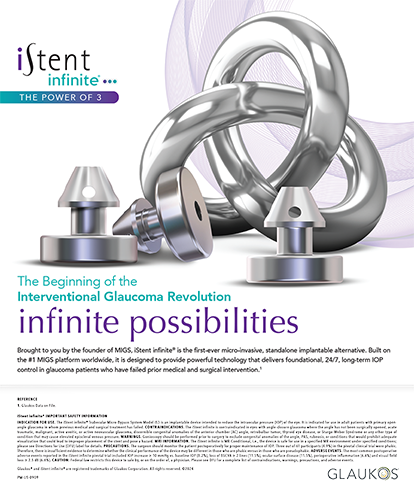Patients who desire premium IOLs such as toric or multifocal lenses judge success by their refractive outcome. Achieving optimal results with the AcrySof IQ Restor IOL (Alcon Laboratories, Inc.) requires the careful selection and counseling of patients, diligent preoperative preparation, and accurate postoperative measurements. These steps in combination with “nailing the prescription” as close to plano as possible have attained excellent results for presbyopic patients in my practice.
COUNSELING PATIENTS
Appropriate candidates for the AcrySof IQ Restor include presbyopes with 1.50 D or less of regular symmetrical astigmatism who have a healthy corneal surface and retina. I find that patients do best with bilateral implantation. I inform them that the likelihood of a successful outcome is high but that, based on my own statistics, they have a 75% to 80% chance of a result within 0.50 D of the target. In my experience, 25% of patients' results fall outside this range and require a touch-up, which is covered in my practice's packages and is generally performed up to 3 months postoperatively.
I am careful to counsel all patients that, although their dependence on glasses will decrease dramatically, they will continue to rely on spectacles for reading small print in dim light. The AcrySof IQ Restor provides vision up to 18 to 22 inches with a 2- to 4-inch sweet spot for reading.
I inform all patients that they should anticipate some side effects, specifically glare and halos at night. The rings that patients see around lights are part of the IOL's design. Some patients claim the rings get better with time, whereas others claim they constantly notice them.
Patients appreciate knowing before surgery that they may require an enhancement and that the IOL can be removed. I talk to patients about the risks associated with explanting the lens. I also explain that, in my practice, explantation occurs in less than 1% of AcrySof IQ Restor cases. The main causes of decreased vision are ocular surface disease and mild posterior capsular opacification, both of which are treatable. If a touch-up will not correct the problem, and I am hesitant to proceed with a YAG capsulotomy because exchanging the lens will be more difficult, I will recommend a lens exchange.
HOW TO GET THE BEST RESULTS
Optimize the Ocular Surface
Preoperative preparation requires optimization of the
ocular surface and a thorough examination to identify
patients with conditions that would preclude good
outcomes and sabotage precise biometry and IOL calculations.
Because poor preoperative measurements will negatively affect the refractive outcome, I delay surgery until the ocular
surface is healthy.
Ocular surface disease (meibomian gland disease, dry eye disease, or aqueous-insufficient dry eye disease) must be remedied before the AcrySof IQ Restor is implanted. I treat ocular surface disease aggressively through copious lubrication and an omega-3 supplement. Omega-3 fats have been shown to improve the meibomian gland orifices.1,2 If the ocular surface is healthy 2 to 4 weeks later, I proceed with the surgery. If the ocular surface shows signs of aqueous insufficiency, I recommend cyclosporine ophthalmic emulsion 0.05% (Restasis; Allergan, Inc.) or punctal occlusion. If meibomian gland dysfunction is the problem, using the LipiFlow System by TearScience, I evacuate the meibomian gland orifices, allowing new oils to form.
Take Meticulous Measurements
It is essential for corneal cylinder to be properly managed, which
requires precise preoperative measurements. In addition to keratometry
readings using the Lenstar (Haag-Streit AG) and the IOLMaster (Carl Zeiss
Meditec, Inc.), I look at corneal topography. I prefer the Lenstar to the
IOLMaster, because I find that the former provides accurate measurements
and a standard deviation. If necessary, I will perform manual keratometry
and compare two or three measurements to ensure I am getting
consistent axes. I prefer the magnitude and axis to each line up with the
Lenstar or IOLMaster or both. I do not go by the topography axis; instead,
I draw a line through the steep axis and use that as my measurement.
Taking precise postoperative measurements for every patient allows surgeons to optimize their outcomes. I use the Holladay 2 formula, but the Haigis formulas are also excellent. The Holladay Consultant software (Holladay Consulting, Inc.) allows me to optimize lens constants in real time. According to the most recent analysis, 91% of my monofocal IOL implants were with 0.50 D of the intended target.
CONCLUSION
Femtosecond laser technology offers the possibility of improving the effective lens position and, ultimately, refractive outcomes for all types of IOLs—monofocal, toric, and multifocal. Through the proper selection and thorough counseling of patients, preoperative optimization of the ocular surface, and accurate pre- and postoperative measurements, surgeons can enhance the quality of life of many presbyopic patients.
Kerry D. Solomon, MD, is a partner at Carolina Eyecare Physicians, the director of the Carolina Eyecare Research Institute, and an adjunct clinical professor of ophthalmology at the Medical University of South Carolina, all located in Charleston. He is a consultant to Alcon Laboratories, Inc. Dr. Solomon may be reached at (843) 881-3937; kerry.solomon@carolinaeyecare.com.
- Paranjpe DR, Foulks GN. Therapy for meibomian gland disease. Ophthalmol Clin North Am. 2003;16(1):37-42.
- Brignole-Baudouin F, Baudouin C, Aragona P, et al. A multicentre, double-masked, randomized, controlled trial assessing the effect of oral supplementation of omega-3 and omega-6 fatty acids on a conjunctival inflammatory marker in dry eye patients. Acta Ophthalmol. 2011;89(7):e591-597.


